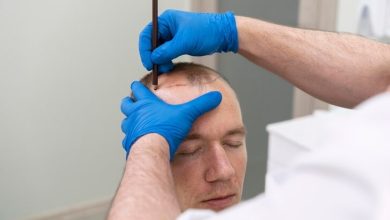Heavy Eyebrows After Botox: Get The Treatment Solution Here!

Heavy eyebrows after Botox are one reason individuals avoid getting Botox injections. Injecting neurotoxins such as Botox and Xeomin just takes a couple of minutes, and it appears quite basic. However, in order to give patients the greatest outcome possible, it is necessary to personalize the results to the patient’s particular objectives and anatomical characteristics.
After getting Botox, many individuals are anxious that they will develop a heavy brow. However, this side effect is not always permanent. Several factors can contribute to this condition, including the type of treatment conducted, the amount of Botox provided, and the patient’s general health. The good news is that facial cosmetic surgeons nowadays have developed various treatments for heavy brows that have the potential to resolve such issues. Here is all one needs to comprehend regarding the formation of heavy eyebrows after Botox!
Eyebrow Drooping After Botox: What Exactly is the Botox Treatment?
Botox is a refined form of the toxin that is generated by the bacterium Clostridium botulinum. It is used to lessen the look of wrinkles on the face that are caused by making facial expressions. These wrinkles also include the horizontal lines that appear across your forehead when you raise your brows, the vertical lines that appear between your brows, sometimes referred to as “elevens,” that appear when you frown, and the “crow’s feet” that appear around your eyes when you smile or squint. All of these wrinkles are caused by repetitive facial expressions.
Botox faster works by relaxing the muscles in the face that are responsible for the creation of wrinkles. An ideal Botox treatment normally starts to be effective within a few days, and after two weeks, it reaches its full potential. On the other hand, the majority of people report that the positive effects of Botox last for approximately three to four months.
Heavy Eyebrows After Botox: Does Botox Really Affect the Eyebrows?
Upper-face wrinkles are typically brought on by facial expressions. Several facial muscles that control these expressions are relaxed with Botox. Horizontal forehead lines might form as a result of frequent frontalis contractions. The frontalis muscle is relaxed with Botox, making it difficult to raise the brows.
You have glabella muscles between your brows. When you tense the glabella muscles, your inner eyebrows will droop and turn inward. Vertical frown lines are produced by these muscles. Botox causes these muscles to relax, making the inner brow pulldown more difficult.
Your eyes are surrounded by the orbicularis oculi muscles. Your eyelids are pulled together by this muscle. Your eyebrow tail descends when you smile or squint. By relaxing this muscle, Botox makes it impossible for you to pull the tail of your eyebrow down.
Can You Fix a Heavy Brow After Botox?
There are a few different approaches to addressing the issue of heavy eyebrows after Botox that might occur after getting Botox. More Botox could be injected into these areas if the areas where you have frown lines or crow’s feet were either not treated with Botox at all or were treated with a low dose of Botox. This will cause the muscles that hold down on your eyebrows to relax, which will result in your eyebrows appearing and feeling lighter as a result. This is something that should be considered for any future Botox treatments.
Additionally, there are times when Botox is applied too low on the forehead. So, the next time you get it done, you can ask to have it applied higher on your forehead. This way, you won’t have to worry about your eyebrows feeling tired or heavy. In addition to that, you might have a brief laser skin tightening treatment performed on the area of your high forehead. This will correct the heavy feeling and pull the eyebrows up at the same time. You may need numerous sessions of laser skin tightening at different intervals, and each session can be performed once per week.
Eyebrow Drooping After Botox: How Can the Risks Be Prevented?
As previously elaborated, various muscles move your eyebrows. Botox can affect eyebrow position if only one muscle is relaxed. Heavy eyebrows after Botox result as raising them is tougher. Botox relaxes the frontalis alone. They do this because they have horizontal forehead lines and don’t mind frown lines or crow’s feet. Botox relaxes the muscle that raises your eyebrows while leaving the muscle that lowers them functioning.
Thus, one feels heavy eyebrows after Botox, and they may even drop. This can also hold the upper eyelids. At the same time, makeup application may be tougher. Treating all eyebrow muscles prevents this side effect. Even if you don’t have frown lines or crow’s feet or don’t mind them, it is advisable to have Botox in these places. This will counteract the weight of Botox on your eyebrows.
Frequently Asked Questions
What is the Main Cause for Heavy Eyebrows After Botox?
From the brow line down to the hairline is where the frontalis muscle can be found. Botox temporarily immobilizes the frontalis muscle, which stops it from moving and eliminates the formation of horizontal creases.
On the other hand, the frontalis muscle is the one that causes the eyebrows to rise. Therefore, it seems to be the reason that inhibiting these muscles would result in heavy eyebrows after Botox.
Can You Fix a Heavy Brow After Botox?
The frontalis muscle, which raises the eyebrows, is relaxed by Botox. In patients who require a brow lift, the brow falls and feels heavy when paralyzed. The sagging brow will naturally lift up after 3 to 4 months because Botox’s effects only last that long.
Conclusion
So, we can deduce from this writing that heavy eyebrows after Botox are just temporary. When your Botox stops working in three months, the heavy feeling will vanish entirely. However, it normally goes away after a week or two.




